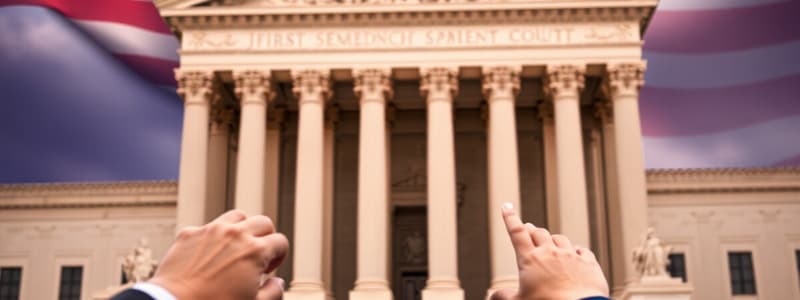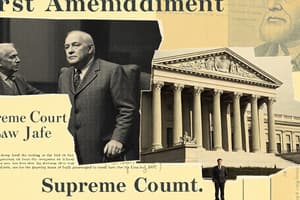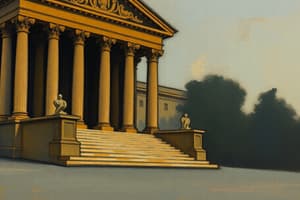Podcast
Questions and Answers
In both Yates v U.S. (1957) & Brandenburg v Ohio (1969), the Supreme Court recognized what important distinction regarding speech?
In both Yates v U.S. (1957) & Brandenburg v Ohio (1969), the Supreme Court recognized what important distinction regarding speech?
- speech that encourages hate of a particular group is never protected
- the government can place limits on speech during times of war
- there is a difference between speech that encourages violence & speech that actually results in violence, with the former being protected & the latter being punishable
- the court acknowledged a difference between encouraging thought & encouraging actions, including actions that merely resulted from speech but were not directly advocated for (correct)
In response to the Bipartisan Campaign Reform Act (McCain-Feingold Act), the United States Supreme Court, in Citizens United v Federal Election Commission (2010), ruled that:
In response to the Bipartisan Campaign Reform Act (McCain-Feingold Act), the United States Supreme Court, in Citizens United v Federal Election Commission (2010), ruled that:
- limits on campaign contributions by minors are constitutional under the First Amendment
- limits on issue advertisements 90 days before an election are unconstitutional
- independent political expenditures by corporations and unions to influence voters are protected by the First Amendment (correct)
- limits cannot be placed upon candidates' contributions to their own campaigns
With respect to prayer in public schools, the United States Supreme Court has ruled that:
With respect to prayer in public schools, the United States Supreme Court has ruled that:
- state-sponsored prayer is permitted by the free exercise clause of the First Amendment
- state-sponsored prayer violates the establishment clause of the First Amendment (correct)
- since educational policy is controlled largely by state governments, the First Amendment does not affect school policy on prayer
- the free exercise clause permits teachers to mandate silent prayer
The United States Supreme Court has used which of the following to incorporate the Bill of Rights into state law?
The United States Supreme Court has used which of the following to incorporate the Bill of Rights into state law?
According to the Clear & Present Danger Test, speech may be more easily restricted
According to the Clear & Present Danger Test, speech may be more easily restricted
Which of the following is true about the right of free speech, as currently interpreted by the Supreme Court?
Which of the following is true about the right of free speech, as currently interpreted by the Supreme Court?
Which of the following statements best describes how citizens regard the rights of free speech and assembly?
Which of the following statements best describes how citizens regard the rights of free speech and assembly?
The Fourteenth Amendment to the Constitution has been interpreted by the Supreme Court to
The Fourteenth Amendment to the Constitution has been interpreted by the Supreme Court to
On which of the following constitutional principles did the Supreme Court base its decision in Engel v. Vitale?
On which of the following constitutional principles did the Supreme Court base its decision in Engel v. Vitale?
Which of the following did the Supreme Court permit in New York Times v. United States?
Which of the following did the Supreme Court permit in New York Times v. United States?
What principle did the Supreme Court affirm in New York Times Co. v. U.S. (1971)?
What principle did the Supreme Court affirm in New York Times Co. v. U.S. (1971)?
Most of the individual protections of the Bill of Rights now apply to the states because of the Supreme Court's interpretation of the Constitution's
Most of the individual protections of the Bill of Rights now apply to the states because of the Supreme Court's interpretation of the Constitution's
The preferred position doctrine—which holds that freedom of expression is so essential to democracy that governments should not punish persons for what they say, only for what they do— can also be seen in the court's creation of which constitutional test?
The preferred position doctrine—which holds that freedom of expression is so essential to democracy that governments should not punish persons for what they say, only for what they do— can also be seen in the court's creation of which constitutional test?
Which of the following would NOT be a situation in which a suspension of the writ of habeas corpus would be considered constitutional?
Which of the following would NOT be a situation in which a suspension of the writ of habeas corpus would be considered constitutional?
The process by which provisions of the Bill of Rights are brought within the scope of the Fourteenth Amendment and so applied to state and local government is known as
The process by which provisions of the Bill of Rights are brought within the scope of the Fourteenth Amendment and so applied to state and local government is known as
Based on decisions like Reynolds v U.S. (1878) & Oregon Employment Div. v Smith (1990), which of the following statements is most applicable to a discussion of the Free Exercise Clause?
Based on decisions like Reynolds v U.S. (1878) & Oregon Employment Div. v Smith (1990), which of the following statements is most applicable to a discussion of the Free Exercise Clause?
When we speak of laws that apply to all kinds of speech and to all views, not just that which is unpopular or divisive, we are referring to what?
When we speak of laws that apply to all kinds of speech and to all views, not just that which is unpopular or divisive, we are referring to what?
Justice Holmes's Clear and Present Danger Test holds that government can
Justice Holmes's Clear and Present Danger Test holds that government can
What is an accurate comparison between Schenck v United States (1919) and Tinker v Des Moines (1969)?
What is an accurate comparison between Schenck v United States (1919) and Tinker v Des Moines (1969)?
The Supreme Court has altered the scope of the Fourth Amendment's protection that every citizen has the right to be free from unreasonable government intrusion into their persons. homes, businesses. and property. Which of the following Statements explains HOW the Court has done this?
The Supreme Court has altered the scope of the Fourth Amendment's protection that every citizen has the right to be free from unreasonable government intrusion into their persons. homes, businesses. and property. Which of the following Statements explains HOW the Court has done this?
Which of the following Supreme Court decisions would allow public school students to wear T-shirts protesting a school board decision that eliminates funding for high school arts programs?
Which of the following Supreme Court decisions would allow public school students to wear T-shirts protesting a school board decision that eliminates funding for high school arts programs?
The 1973 Roe v. Wade decision that upheld a woman's right to secure an abortion was based on the right to
The 1973 Roe v. Wade decision that upheld a woman's right to secure an abortion was based on the right to
Which of the following did the Supreme Court assert in Gideon v. Wainwright?
Which of the following did the Supreme Court assert in Gideon v. Wainwright?
Which protection bars the use of illegally seized evidence at trial?
Which protection bars the use of illegally seized evidence at trial?
The free exercise clause states that the national government will not interfere with which of the following?
The free exercise clause states that the national government will not interfere with which of the following?
What founding principle has been frequently cited as a basis for opposition to the Court's occasional application of the Bill of Rights protections to the state & local governments?
What founding principle has been frequently cited as a basis for opposition to the Court's occasional application of the Bill of Rights protections to the state & local governments?
If a police officer has a reasonable belief that someone is engaged in criminal activity, that officer can conduct a Terry Search ______ .
If a police officer has a reasonable belief that someone is engaged in criminal activity, that officer can conduct a Terry Search ______ .
Which of the following best represents the reasoning used by the Supreme Court in Church of the Lukumi Babalu Aye, Inc. v. City of Hialeah, in which the Court overturned a city ordinance prohibiting the ritual killing of animals as part of religious ceremonies?
Which of the following best represents the reasoning used by the Supreme Court in Church of the Lukumi Babalu Aye, Inc. v. City of Hialeah, in which the Court overturned a city ordinance prohibiting the ritual killing of animals as part of religious ceremonies?
In McDonald v. Chicago (2010), the United States Supreme Court stated that, "[s]elf-defense is a basic right, recognized by many legal systems from ancient times to the present day" and that an individual's right to bear arms was "deeply rooted in this Nation's history and tradition." Which amendment was at issue in McDonald?
In McDonald v. Chicago (2010), the United States Supreme Court stated that, "[s]elf-defense is a basic right, recognized by many legal systems from ancient times to the present day" and that an individual's right to bear arms was "deeply rooted in this Nation's history and tradition." Which amendment was at issue in McDonald?
Which of the following is an accurate comparison of the two court cases?
Which of the following is an accurate comparison of the two court cases?
Flashcards
Yates v. U.S. (1957) & Brandenburg v. Ohio (1969)
Yates v. U.S. (1957) & Brandenburg v. Ohio (1969)
The Supreme Court recognized that there is a difference between encouraging thoughts and encouraging actions, even if those actions are merely a result of speech but not directly advocated for. This is important because it allows for freedom of expression while still protecting society from harmful actions.
Citizens United v. Federal Election Commission (2010)
Citizens United v. Federal Election Commission (2010)
The Supreme Court ruled that corporations and unions are entitled to spend unlimited amounts of money on political campaigns due to their right to free speech, as protected by the First Amendment.
Prayer in Public Schools
Prayer in Public Schools
The Supreme Court has repeatedly ruled that state-sponsored prayer in public schools violates the Establishment Clause of the First Amendment, which prohibits the government from establishing a state religion.
Incorporation of the Bill of Rights
Incorporation of the Bill of Rights
Signup and view all the flashcards
Clear and Present Danger Test
Clear and Present Danger Test
Signup and view all the flashcards
Freedom of Speech: Symbolic Speech
Freedom of Speech: Symbolic Speech
Signup and view all the flashcards
Public Attitudes toward Free Speech and Assembly
Public Attitudes toward Free Speech and Assembly
Signup and view all the flashcards
The Fourteenth Amendment and Incorporation
The Fourteenth Amendment and Incorporation
Signup and view all the flashcards
Establishment Clause and Engel v. Vitale (1962)
Establishment Clause and Engel v. Vitale (1962)
Signup and view all the flashcards
Prior Restraint and New York Times v. United States (1971)
Prior Restraint and New York Times v. United States (1971)
Signup and view all the flashcards
Due Process Clause and Incorporation
Due Process Clause and Incorporation
Signup and view all the flashcards
Preferred Position Doctrine
Preferred Position Doctrine
Signup and view all the flashcards
Imminent Lawless Action Test
Imminent Lawless Action Test
Signup and view all the flashcards
Suspension of Habeas Corpus
Suspension of Habeas Corpus
Signup and view all the flashcards
Selective Incorporation
Selective Incorporation
Signup and view all the flashcards
Free Exercise Clause & Limitations
Free Exercise Clause & Limitations
Signup and view all the flashcards
Content or Viewpoint Neutrality
Content or Viewpoint Neutrality
Signup and view all the flashcards
Clear and Present Danger Test (Schenck v. United States)
Clear and Present Danger Test (Schenck v. United States)
Signup and view all the flashcards
Tinker v. Des Moines (1969) & Student Speech
Tinker v. Des Moines (1969) & Student Speech
Signup and view all the flashcards
Warrantless Searches of Vehicles
Warrantless Searches of Vehicles
Signup and view all the flashcards
Tinker v. Des Moines and Student Expression
Tinker v. Des Moines and Student Expression
Signup and view all the flashcards
Roe v. Wade and the Right to Privacy
Roe v. Wade and the Right to Privacy
Signup and view all the flashcards
Gideon v. Wainwright & Right to Counsel
Gideon v. Wainwright & Right to Counsel
Signup and view all the flashcards
Exclusionary Rule
Exclusionary Rule
Signup and view all the flashcards
Free Exercise Clause
Free Exercise Clause
Signup and view all the flashcards
Federalism and Incorporation
Federalism and Incorporation
Signup and view all the flashcards
Terry Search
Terry Search
Signup and view all the flashcards
Church of the Lukumi Babalu Aye, Inc. v. City of Hialeah
Church of the Lukumi Babalu Aye, Inc. v. City of Hialeah
Signup and view all the flashcards
McDonald v. Chicago & the Second Amendment
McDonald v. Chicago & the Second Amendment
Signup and view all the flashcards
Comparing Engle v. Vitale & Wisconsin v. Yoder
Comparing Engle v. Vitale & Wisconsin v. Yoder
Signup and view all the flashcards
Study Notes
Question 1
- Supreme Court recognized important distinctions in Yates v U.S. (1957) and Brandenburg v Ohio (1969) regarding speech limitations during wartime
- The court acknowledged a difference between encouraging thought or actions and actions that merely result from speech, but not directly advocated.
Question 2
- Independent political expenditures by corporations and unions to influence voters are protected by the First Amendment
- Limits on campaign contributions by minors are constitutional under the First Amendment
Question 3
- With respect to prayer in public schools, the Supreme Court ruled that since educational policy is largely controlled by state governments, the First Amendment does not affect school policy on prayer.
Question 4
- The Fourteenth Amendment's Due Process Clause was used to incorporate the Bill of Rights into State law.
Question 5
- According to the Clear & Present Danger Test, speech may be more easily restricted whenever the U.S. is at war or when speech incites violent action.
Question 6
- (No information provided regarding question six)
Question 7
- Free speech is protected from federal infringement, but not from state infringement
- Free speech protects the right to express opinions even without the use of words (e.g., symbolic speech).
- Citizens have the right to disobey laws that they believe are unjust, but this right is not absolute.
Question 8
- The Fourteenth Amendment has been interpreted by the Supreme Court to prevent states from taxing agencies of the federal government.
Question 9
- The Supreme Court based its decision on Engel v. Vitale (1962) on the Establishment Clause
Question 10
- The Supreme Court permitted the publication of the Pentagon Papers in New York Times v. U.S. (1971)
Question 11
- The Supreme Court affirmed the principle of preventing prior restraint on printed news publications in New York Times Co v U.S.
Question 12
- The Due Process Clause of the Fourteenth Amendment is the principle by which provisions from the Bill of Rights were incorporated into state law.
Question 13
- (No information provided regarding question thirteen)
Question 14
- Several states seceding from the union in the wake of Abraham Lincoln's election is not a situation in which suspending the writ of habeas corpus would be considered constitutional.
Question 15
- The process of incorporating Bill of Rights provisions into state and local governments is known as selective incorporation.
Question 16
- Free exercise can be subordinate to laws that are broadly applied to society, as long as they aren't explicitly targeted at religious practices.
- Free exercise does not contradict the separation of church and state.
Question 17
- Laws that apply to all kinds of speech are considered "content- and viewpoint-neutral".
Question 18
- (No information provided regarding question eighteen)
Question 19
- Schenck v. United States (1919) and Tinker v Des Moines (1969) contrasted by the protection of "fighting words" versus expressive symbolic speech.
Question 20
- (No information provided regarding question twenty)
Question 21
- The Supreme Court altered the scope of the Fourth Amendment's protection by stating that a warrant isn't always required to search vehicles with probable cause that a crime is linked to a vehicle.
Question 22
- Roe v. Wade (1973) was based on the right to life, liberty, and the pursuit of happiness, implied in the Declaration of Independence
Question 23
- Gideon v. Wainwright (1963) asserts that a proper defense is essential for a fair trial at any level of government.
Question 24
- (No information provided regarding question twenty-four)
Question 25
- The exclusionary rule bars the use of illegally seized evidence in a trial.
Question 26
- Federalism is a basis for opposition to the Court's application of Bill of Rights protections to state and local governments.
Question 27
- A police officer can conduct a Terry Search if they have a reasonable belief that criminal activity is occurring, and intend to arrest the suspect.
Question 28
- (No information provided regarding question twenty-eight)
Question 29
- The Fourteenth Amendment and the right to bear arms are at issue in McDonald v. Chicago (2010).
Question 30
- Engle v. Vitale (1962) is about the establishment clause, and Wisconsin v. Yoder (1972) is about the free exercise clause.
Studying That Suits You
Use AI to generate personalized quizzes and flashcards to suit your learning preferences.




